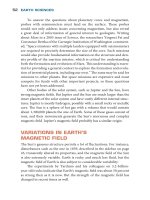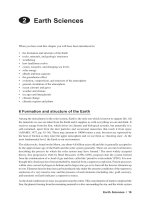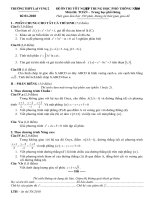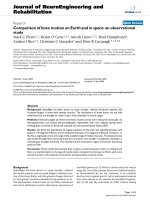- Trang chủ >>
- Khoa Học Tự Nhiên >>
- Vật lý
5 5 water on earth (earth sciences)
Bạn đang xem bản rút gọn của tài liệu. Xem và tải ngay bản đầy đủ của tài liệu tại đây (8.05 MB, 12 trang )
Earth Sciences
Standards
Preview
Standard Set 3. Earth Sciences
3. Water on Earth moves between the
oceans and land through the processes
of evaporation and condensation. As a
basis for understanding this concept:
3.a. Students know most of Earth’s
water is present as salt water in the
oceans, which cover most of Earth’s
surface.
3.b. Students know when liquid water
evaporates, it turns into water vapor
in the air and can reappear as a liquid
when cooled or as a solid if cooled
below the freezing point of water.
Genre
Nonfiction
Comprehension Skill
Main Idea and Details •
•
•
•
3.c. Students know water vapor in
the air moves from one place to
another and can form fog or clouds,
which are tiny droplets of water or
ice, and can fall to Earth as rain, hail,
sleet, or snow.
3.d. Students know that the amount
of fresh water located in rivers, lakes,
underground sources, and glaciers is
limited and that its availability can be
extended by recycling and decreasing
the use of water.
3.e. Students know the origin of water
used by their local communities.
Text Features
Captions
Labels
Diagrams
Glossary
Science Content
Water on Earth
Scott Foresman Science 5.5
ISBN 0-328-23464-8
ì<(sk$m)=cdegeg< +^-Ä-U-Ä-U
by Kristin Cashore
Vocabulary
aquifer
condensation
evaporation
precipitation
reservoir
salinity
sea level
sleet
water cycle
water table
watershed
Picture Credits
Every effort has been made to secure permission and provide appropriate credit for photographic material.
The publisher deeply regrets any omission and pledges to correct errors called to its attention in subsequent editions.
Unless otherwise acknowledged, all photographs are the copyright © of Dorling Kindersley, a division of Pearson.
ISBN: 0-328-23464-8
Copyright © Pearson Education, Inc. All Rights Reserved. Printed in the United States of America.
This publication is protected by Copyright, and permission should be obtained from the publisher prior to any
prohibited reproduction, storage in a retrieval system, or transmission in any form by any means, electronic,
mechanical, photocopying, recording, or likewise. For information regarding permission(s), write to
Permissions Department, Scott Foresman, 1900 East Lake Avenue, Glenview, Illinois 60025.
1 2 3 4 5 6 7 8 9 10 V010 13 12 11 10 09 08 07 06
by Kristin Cashore
How can the oceans
be described?
The Hydrosphere
Bodies of water, such as rivers, lakes, and oceans, are
very important to us. We can travel and catch food on
bodies of water. We can enjoy them for their natural beauty.
What bodies of water are near you?
The hydrosphere is made up of all of the water on
Earth. It covers three-fourths of Earth’s surface.
Oceans, rivers, and lakes are all part of
the hydrosphere. Only 3/100 of the
hydrosphere is not in the ocean.
The Pacific Ocean is the
biggest ocean. Next comes the
Atlantic Ocean, the Indian
Ocean, the Southern
Ocean, and the Arctic
Ocean. The oceans
are all connected to
each other.
2
The Pacific Ocean is the biggest ocean. It is the deepest
ocean too. Its average depth is about 4,000 meters. It is
more than 11,000 meters deep at its deepest place.
Every ocean is different. Each ocean’s water is at
different average depths. Some have more storms than
others do. They have different temperatures and different
amounts of salt. Even sea level, the level of the ocean’s
surface, is slightly different from ocean to ocean.
3
Earth’s Oceans
Ocean Temperatures
Ocean water is salty. Rivers make the oceans salty. Rain
falls on the oceans and the land. Rain can dissolve salts
and other minerals when it falls on land. Rivers then carry
these salts and minerals into the oceans. Water evaporates
from the surface of the ocean, but the salts are left behind
in the water.
Salinity is a measure of the amount of salt in water.
Some parts of the ocean have less salt than others. Places
where fresh water from rivers flows into the ocean have low
salinity. In warm, dry places ocean water evaporates fast.
This leaves salt behind, so the ocean has a higher salinity.
Cold water with high salinity weighs more than the
same amount of water that is warmer. It also weighs more
than the same amount of water with lower salinity. The
blue-colored water below is warmer and has lower salinity
than the clear water. The blue water floats on the clear
water because of this.
Not all ocean water is at the same temperature. Ocean
water near the equator is about 30°C. Ocean water near the
poles can be as cold as a –2°C.
Currents in the ocean move water back and forth. Some
currents carry warm water toward the poles. The Gulf
Stream is one current that does this. It brings warm water
from the Carribean Sea to the North Atlantic Ocean. Other
currents carry cold water toward the equator. The California
Current runs along the west coast of the United States. It
brings cold water toward the south.
The blue water is at room
temperature and has one-half of
a spoonful of salt. The red water
is warm and has no salt. The
blue layer floats on top of the
clear water, which is cold and has
more salt.
4
Ocean Resources
The oceans are very important to our Earth. People get
food and other materials from the ocean. A lot of the salt
we use for food is from the ocean. People who process salt
let ocean water flow into shallow ponds. When the water
evaporates, salt is left behind.
When ocean water in these ponds
evaporates, salt is left behind.
5
Where is fresh water
found?
Drinking water is also called fresh water. Fresh water
has much less salt than seawater. Almost all fresh water
begins as rain or snow. Some sinks into the ground. Some
collects in rivers and lakes. Some freezes into ice sheets and
glaciers.
Some places have much more fresh water than others.
But fresh water around the world is limited. People should
try to use less water. They should recycle water if they can.
Groundwater
Groundwater is rain or melted snow that sinks into the
ground. Groundwater fills spaces between pieces of rock and
soil. It sinks until it reaches a layer of rock or clay it cannot
move through. Water can flow over these layers.
The layer of rock and
soil that groundwater flows
through is called an aquifer.
The top level of groundwater
in an aquifer is the water
table. The level of the water
table depends on how much it
rains or snows. People can use up
the water in an aquifer if they are
not careful.
6
Rivers
Rivers, streams, and lakes are all surface waters. Creeks
run downhill, full of rainwater and melted snow. The creeks
join to form streams and rivers. Groundwater also seeps
into rivers. Most rivers flow into the ocean. A watershed is
the area from which water drains into a river.
A watershed can have a big effect on a river. If
chemicals are dropped in a watershed, they can be carried
by water to rivers. This can change river ecosystems.
Lakes
Lakes form when water collects in a low spot. Lakes
may be surrounded by higher land or blocked by a dam. A
reservoir is usually an artificial lake that forms behind
a dam.
A lake, pond, stream, or
swamp forms where the
water table meets the
surface.
7
Ice
Getting Water to Homes
About seven-tenths of Earth’s fresh water is frozen!
This makes it hard for people to use. In Greenland and
Antarctica, big ice sheets cover most of the land. The sheets
can be several kilometers thick. These places are where
much of Earth’s ice is found.
In the United States, some towns get water from
groundwater or surface water. But sometimes this water has
harmful bacteria or is polluted with chemicals. Water must
first be treated before it is safe to use.
Water is treated at a treatment plant. First, water is
pumped from a river or lake through screens to a tank.
Then, chemicals are added to the water. These chemicals
make small particles stick together. The larger particles
that are formed then sink to the bottom of the tank. Next,
the water passes through filters made of sand and gravel.
The filters take out smaller particles. Finally, even more
chemicals are added to the water. Chemicals such as
chlorine kill harmful bacteria. After the water is treated, it
is stored in a water tower.
Now you know that a lot must happen before water
gets to your home. This is why it is very important not to
waste water.
Glaciers
Smaller sheets of ice are called glaciers. Valley glaciers
sit in the valleys of high mountains. They move slowly
downhill. As they move, they cut into the rock and move it.
This changes the shape of the valley.
Glaciers and ice sheets form when the amount of
snowfall is greater than the amount of snow that melts.
Over time, the snow underneath is pressed into ice by the
snow on top. Large pieces of glaciers and ice sheets can
break off into the ocean. These pieces are called icebergs.
This iceberg is in
Greenland. Only 1/10 of
the iceberg floats above
the water. You cannot
see the 9/10 that is
underwater.
8
9
What are some
California water
sources?
Too Much or Not Enough?
Some parts of California get a lot of rain. Other parts
are very dry. The northern coastal region of California gets
about 250 centimeters of rain every year. But the deserts of
southeastern California get only about 10 centimeters of
rain every year. Because of this, the supply of fresh water in
southern California is limited. However, southern California
uses about two-thirds of the fresh water used in the state!
A lot of California’s water comes from winter snow.
When the snow melts, its fresh water runs from the
mountains into streams and lakes. This water is collected
and sent all over the state.
Transporting Water Throughout
California
Aqueducts help to carry water throughout California.
An aqueduct is a system of pipes that carries water from
one place to another. Aqueducts carry water from rivers and
lakes to where it is needed.
There are many aqueducts in California. The California
Aqueduct brings water from the mouth of the Sacramento
River to communities more than 400 kilometers away.
The Los Angeles Aqueduct carries water from a number of
sources to Los Angeles. The Colorado River Aqueduct carries
water from the Arizona border to Riverside County. That is
a distance of almost 390 kilometers! From there it travels
south to San Diego.
Melted snow runs out of the
Sierra Nevada. It provides
drinking water to many
Californians.
10
11
Local Water Sources
Reclamation
Did you know that everyone lives in a watershed? The
amount of water in the watershed determines how much
water an area has to use. Water from rain and snow falls in
streams, rivers, and lakes. Water also sinks into the soil and
becomes groundwater. Both surface water and groundwater
are available for people to use.
The way land in a watershed is used affects how clean
the water is. Chemicals that are use in cities and on farms
can be carried in water that runs off streets and farms. Soil
that is being disturbed by construction can also get into
water. The land must be used wisely to help keep water safe.
This is why there are laws to keep water safe.
Conservation is using a resource such as water wisely
so that it lasts longer. Taking shorter showers and fixing
leaky faucets and toilets are some of the ways people can
conserve water.
Water can be recycled and used again. This is called
reclamation. In reclamation, wastewater is carried to a
treatment plant. After being treated, the water can be used
for things other than drinking. For example, it can be used
to water lawns or crops.
Finding Out About Local Water Sources
Some places get their fresh water from nearby water
sources. Other places use aqueducts to get water from
far away.
The amount of water in these lakes and rivers depends
on how much rain and snow falls there. It also depends on
how people use the water.
Where does your water come from? Try contacting
your local water company or going to the library-media
center to find out.
This farm uses reclaimed water for
watering crops to help save water.
12
13
The Water Cycle
What is the
water cycle?
Water in the Air
Did you know that the air around you has water in it?
This water is not in a liquid form, like the water in a river. It
is also not in a solid form, like the ice in a glacier. The water
in the air is an invisible gas called water vapor.
Air always has some water vapor in it. Even desert air
contains water vapor. Water vapor was liquid water at some
time in the past. It may have been part of a river or an
ocean, or may have even been inside a plant!
The particles of water vapor are like the particles of
other gases. They are always moving.
Water moves from the oceans to the land and back
again through a process called the water cycle. The
water cycle is the repeated movement of water through
the environment in different forms. It is also called the
hydrologic cycle. The water cycle has many steps.
Evaporation is the changing of liquid water to water
vapor. Liquid water changes into water vapor when it is
heated by the Sun. Condensation happens when air cools
water vapor. Condensation is the changing of water
vapor back into a liquid, such as water droplets in clouds
or fog. The droplets are so small that they hang in the air.
In precipitation, the air cools the water droplets even
more. The water droplets grow big and heavy, and fall as
rain, hail, sleet, or snow. Water can go many different ways
through the water cycle.
Condensation
Precipitation
Evaporation
14
15
Many Paths of the Water Cycle
Energy in the Water Cycle
The water cycle is not as simple as it seems. Water is not
always in the nonliving part of the environment. Living
things use water. During photosynthesis, plants break down
water as they make sugar. Living things also release water.
They do this during respiration.
The energy of the Sun is very important to the water
cycle. Sunlight causes melting and evaporation. It also
causes sublimation, or the changing of ice directly to water
vapor. The energy to raise water vapor to the clouds comes
from the Sun. The energy to move water vapor with winds
also comes from the Sun.
When water vapor condenses into liquid water, it
releases energy. This energy heats nearby air or water.
When liquid water evaporates, it takes in heat energy.
This cools nearby air and water.
This heating and cooling can affect
weather patterns.
As water vapor rises,
it may form a cloud.
Water runs off the
land and evaporates
from plants.
Groundwater slowly
moves through
aquifers into rivers,
lakes, and the ocean.
16
Because salt is left
behind when water
evaporates, the
oceans remain salty.
17
How do clouds form?
Temperature and Pressure
Clouds come in many shapes and sizes. They form when
water vapor condenses. This forms water droplets or ice
crystals. The condensation of water vapor to form clouds is
an important part of the water cycle.
The temperature of the air is part of why a cloud is
made of water droplets or ice crystals. It is much colder in
the clouds than it is on the ground. Even on hot days, many
clouds are made of ice crystals.
Air pressure also affects the way clouds form. Clouds
often form when air rises into areas of lower air pressure. As
air rises, the pressure goes down. With less pressure, the air
expands and cools. If the air cools enough, water vapor will
form droplets or ice crystals.
Cirrus clouds are high-altitude clouds
that are thin, wispy, and white.
Precipitation
Most rain in the United States starts as snow. This is
because the temperature of the air up high is often below
0°C. Clouds made of ice crystals form. The crystals grow
bigger until they fall as snowflakes. If the temperature of
the air between the cloud and the ground is less than 0°C,
the ice crystals fall to the ground as snow.
Falling ice crystals may change as they pass through
different layers of air. Ice crystals will melt if they go through
air that is warmer than 0°C. Then they will fall as rain. If the
air near the ground is very cold, the rain may freeze before
it hits the ground. These frozen raindrops are sleet. Freezing
rain forms when rain freezes right as it hits the ground.
Hail Formation
Hail forms when strong winds blow upward into a
cloud. The winds blow raindrops up into the freezing air at
the top of the cloud. The raindrops freeze into pieces of ice.
The winds blow the ice back up into the cloud many times.
More layers of water freeze onto the ice. Hailstones fall
when pieces of ice grow too heavy for the winds to lift.
Vertical clouds are sometimes called
thunderheads because they often
cause thunderstorms.
18
19
Glossary
aquifer
condensation
the layer of rock and soil that
groundwater flows through
the process by which particles leave a gas
and become a liquid
evaporation
the process by which particles leave a
liquid and become a gas
precipitation
water that falls from clouds as rain, hail,
sleet, or snow
reservoir
usually an artificial lake that forms
behind a dam
salinity
a measure of the amount of salt in water
sea level
the level of the surface of an ocean
sleet
frozen raindrops that fall as precipitation
water cycle
the repeated movement of water through
the environment in different forms
water table
the top level of the groundwater in an
aquifer
watershed
the area from which water drains into
a river
20
What did you learn?
1. What is likely to happen if a factory drops harmful chemicals on
the ground in the watershed of a river?
2. What part do plants and animals play in the water cycle?
3. How is hail formed?
4.
You learned about the importance of
preserving and protecting our water. Write a story about a student
who does something to protect the water in his or her watershed.
Be sure to use a lot of description.
5.
Main Idea and Details California has a limited supply of fresh
water. List details that support this idea.









